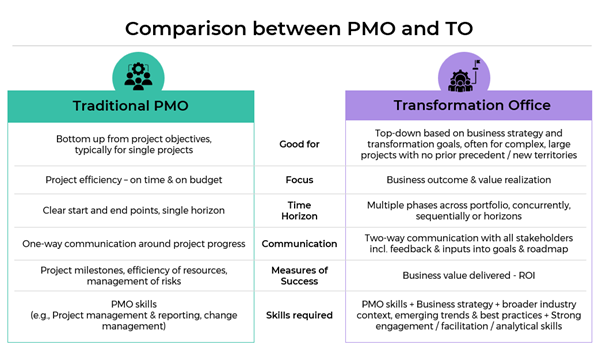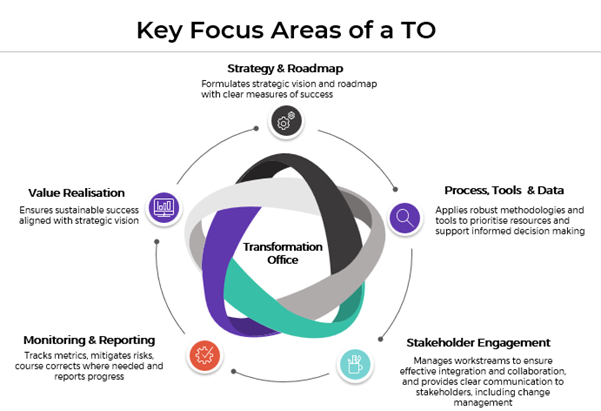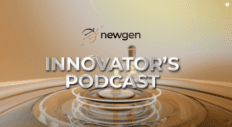Traditional Project Management is Insufficient for National Digital Transformation
- Large-scale national digital transformation programs, especially in public health, face complexities that go beyond traditional IT project management approaches. A Transformation Office (TO) is essential to navigate ambiguity, drive stakeholder alignment, and ensure value realization beyond compliance and reporting. Unlike a traditional Project Management Office (PMO), a TO focuses on user needs, problem-solving, and adaptability.
- To achieve sustainable impact, organizations must establish: Clear ways of working upfront, Outcome-driven metrics, Fact-based decision-making and An agile mindset, while celebrating small wins along their multi-year journey
- Building a Resilient and Adaptive Culture is Crucial: Successful transformation programs require stakeholder engagement, adaptability, and a milestone-based approach. Regular retrospectives, embracing user perspectives, and celebrating both big and small wins help sustain momentum. The ability to anticipate and respond to challenges ensures that national healthcare transformation efforts align with long-term goals like HealthierSG and Smart Nation 2.0.
High stakes, complex challenges and intense pressure to deliver timely and impactful results are faced by every digital transformation programme. These issues are amplified in public sector programmes, including public health, where its national scale impact and interconnected stakeholders and processes add further complexity.
Running these national programmes requires a fundamentally different approach that go beyond the traditional IT project management. Specifically, the traditional Project Management (PM) or Project Management Office (PMO) constructs may prove to be insufficient when a programme is fraught with ambiguity from the outset. Instead, a Transformation Office (TO) needs to be established to ensure value and sustainable impact for programmes of this scale.
Battling the waves of challenges
Embarking on a large-scale digital transformation programme is like taking a massive crew through a long journey on uncharted waters—it can be daunting even for the most experienced sailors. In the public sector, this means optimising processes on a nation level, involving multiple high-level stakeholders in decision-making, integrating more complex technology requirements, and the need to justify ROI and “˜value for money’.
In fact, public sector projects are faced with evolving tech requirements and strict budget cycles and processes and a study has shown that 84% of public sector projects globally experience some form of failure. Lack of experienced technical expertise to manage the end-to-end digitalisation process, organisational silos and leadership changes are common root cause challenges in any organisation. In health, quality and precision (patient safety, compliance) standards are high, whilst also balancing cost and access.
Same, same – what needs to be different?
The traditional IT project management approach is appropriate and effective in many projects. It prioritises process and compliance, offering a regular cadence of reporting and standardisation across functions and through a project life cycle. However, this emphasis on standardised process and compliance can become a limiting factor in delivering impact in complex national programmes. This is because true digital transformation goes beyond status tracking, reporting and risk escalation.
Instead, a Transformation Office (TO) needs to be set up to serve as the critical link between executive vision and programme objectives, with the daily activities of a project. A TO ensures user needs and perspectives are embedded and problems are assessed holistically and evidence-based.

Who is in a TO?
A TO needs to consist of at least 3-5 dedicated team members consisting of a diverse, experienced team of consultants and designers that are embedded in the project specifically to drive stakeholder buy in, help with people and process redesign aligned with the technology and problem solving. These team members are then supported by architects and sponsored by project executives.
Beyond the team’s structure and skillsets, a TO’s approach to a transformation programme is radically different from that of project managers. The TO emphasize materiality by embedding user priorities and perspectives throughout the project and anticipate risks and challenges, not just report in a cadence. As effective collaborators, they “˜roll up their sleeves’ to help drive relentless, fact-based, problem-solving with a high degree of adaptability.
To succeed, organisations must adopt dynamic project management practices in a variety of situations and maintain a focus on value-realisation throughout the project lifecycle.

Roadmap for Transformation Success
Based on the principles of Figure 1, the Transformation Office ensure that all resources are maximised and geared towards achieving measurable success. These require the following:.
- Establishing clear ways of working upfront: Defining the “ways of working” across the entire delivery team and key sponsors including system and product owners is crucial. This includes defining roles, responsibilities and collaboration structures (e.g., communication channels, ways to remove roadblocks etc.), overall milestones and plans and risks. This is not a single administrative “kick off” meeting, but a crucial foundational process for effective teaming. It set basis for building an open repertoire and trust, initiates relationship within the teams and starts the tone of the “˜team culture’ for the programme, regardless of whether a person is a client, vendor and/or contractors.
- What gets measured gets done: Traditional project management metrics measure budget and timelines. These are important hygiene metrics to track. For larger scale, complex transformation projects, the objective is to enhance experiences, address real needs and deliver tangible value. These broad objectives or metrics therefore need to be defined and act as a “˜north star’ beyond budgets and dates. This shift in perspective will foster alignment between technology, processes, and outcomes.
- Embrace user priorities and perspectives: Taking time to understand pre-existing cultures and practices of the organisation to ensure buy-in from key stakeholders and users is an important yet frequently overlooked step. Making the benefits of the change relevant and personalised to end users helps ensure openness to change. Endorsement and clear communication and direction from leadership throughout the programme is critical.
- Fact-based decision-making: Particularly in a complex healthcare environment, evaluating choices based on business impact on both hospitals and patients must take precedence. The temptation to adopt the latest technology can quickly overshadow the need to first understand true underlying challenges and stakeholder needs. Being able to truly solve challenges, even if it’s using mature or “˜cheap and cheerful’ solutions, will serve as tangible evidence to the success of initiatives and justification for future digital transformation investments.
- Milestone-based approach and disciplined retrospectives: No long voyage is complete in one stretch. A milestone-based approach breaks down a long journey into tangible, achievable outcomes. High performing teams also prioritise and conduct disciplined retrospectives. It is part of the continuous improvement culture and ensures progress towards subsequent milestones are achieved more effectively.
- Agile mindset: Keeping an eye out for blind spots, emerging technologies, and shifting policies during the span of multi-year initiatives allow for the revision of action plans and innovation. By revisiting initial assumptions and implementation timeline, organisations can better assess long-term impacts and remain adaptable to future challenges.
- Celebrating wins: Transformation is hard and can be highly frustrating work. As such, celebrating wins—both big and small—helps sustain momentum and reinforces the commitment to long-term goals. Recognising contributions of individuals and teams fosters morale and creates a culture of collaboration and shared success.
Pressing on for Future Voyages
Singapore’s journey towards a new digital era will continue to gain momentum with Smart Nation 2.0 and sector-wide transformation initiatives like HealthierSG. As this transformation progresses, public sector organisations will continue to face increasing complexity from the ever-evolving nature of IT, a shift from application-centric models to platform-based approaches, and growing technology capital expenditure (CapEx) and operating expenditure (OpEx).
The journey ahead, especially for national programmes, will be challenging but also rewarding. A Transformation Office is critical to address those challenges to deliver true lasting value for teams, the sector, the nation and her people.
GovInsider first featured an adaptation of this post on Feb 07, 2025.




